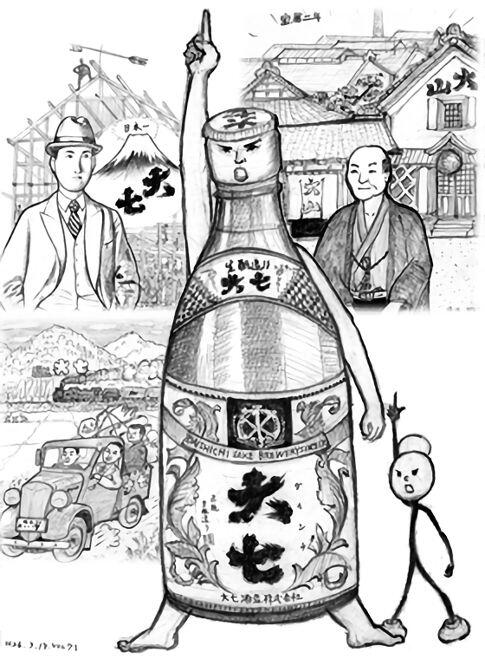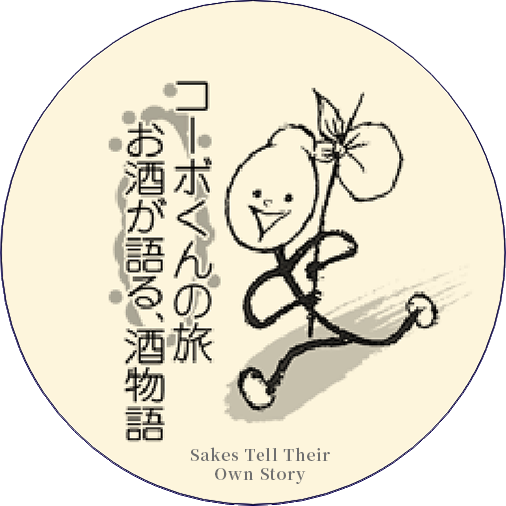| Yeast |
“Today I’m looking forward to meeting Daishichi’s oldest sake, Seishu Daishichi.” |
|
 |
| Daishichi |
“Hello, Yeast.” |
| Yeast |
“You look much younger than I thought.” |
| Daishichi |
“I keep in training so that I always feel young.” |
| Yeast |
“Can you tell me about your history?” |
| Daishichi |
“As you know, in 1752, when the 1st Generation became independent and set up the present brewery, the brand name was “Oyama.” Perhaps this name was related to Oyama in Ise province from where the Ohta family came.” |
| Yeast |
“When became the name Daishichi?” |
| Daishichi |
“When the 8th Generation became the new, young head, he noticed that there were many breweries using the brand name “Oyama,” so he devised a unique new name by using part of the hereditary name of the family head, ‘Shichiuemon.’ Wanting to become the first in Japan, the 8th Generation climbed Mt Fuji and after that directly went to the trademark office to have ‘Daishichi’ registered. That was on July 7 of the year Taisho 7 (1918).” |
| Yeast |
“Cool!” |
| Daishichi |
“The first label featured a pine tree and Mt Fuji rising up high above it.” |
| Yeast |
“The pine tree (matsu) is the symbol of Nihonmatsu.” |
| Daishichi |
“Indeed. In 1935 the 8th Generation bought the first Datsun truck sold in Fukushima and drove around Northeastern Japan to set up bill boards with ‘Sake is Daishichi’ - something we now would call ‘corporate identity.’” |
| Yeast |
“At one time there were quite many of those, a sort of tradition of Tohoku.” |
| Daishichi |
“We changed the design of the label in 1992, at the occasion of Daishichi’s 240th anniversary. It now is a combination of classic and modern, with acanthus leaves and Daishichi’s symbol mark.” |
| Yeast |
“Is the acanthus leaf a symbol of immortality and love of art? And hasn’t it also the meaning of overcoming difficulties and attaining glory? |
| Daishichi |
“Exactly. There is also a tradition that those who give this plant to each other will not suffer separation.” |
| Yeast |
“The motif of the border around the label consists of rice grains. Of course flat polished!” |
| Daishichi |
“You are well informed. Everywhere elements typical of Daishichi have been drawn on the label.” |
| Yeast |
“How is Seishu Daishichi made?” |
| Daishichi |
“The way I am brewed doesn’t differ that much from the basic process for top-class sake. The rice is carefully polished with the flat polishing technique, and then steamed with cast iron cauldrons. As rice for the koji only the special sake rice Gohyakumangoku is used. And just as with top-class sake, in the koji room koji spores are carefully sprinkled on the steamed rice, and the koji is handmade using koji trays. After the main mash has been fermented, we adjust the taste with brewer’s alcohol, but we only use alcohol made from rice.” |
| Yeast |
“There are no corners cut during brewing and great care is taken. As you possess the true kimoto taste, you are a real bargain! |
| Daishichi |
“The local people have always loved this sake. Although a long time ago I have been surpassed by Junmai Kimoto as our number one bestselling product, it is important also today to provide a delicious nightcap for the people of Nihonmatsu and Fukushima.” |
| Yeast |
“You’re right. Tell me finally about the best way of serving you and food pairings.” |
| Daishichi |
“A good nightcap sake has to be all-mighty, it must be possible to drink it both cold and warm. As regards dishes: from sashimi to hotpot, Chinese food, hamburgers. Juicy fried chicken is also very good with this sake when it is served warm.” |
| Yeast |
“Thank you!” |





